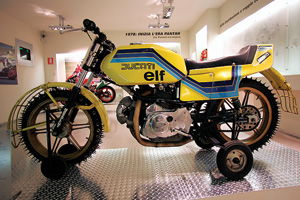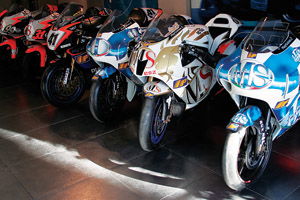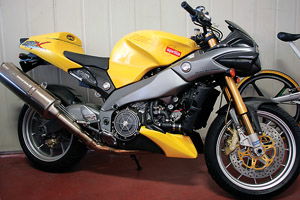Dream Factories - Tours of Aprilia and Ducati
Back in 2005, Niall and Jon explored inside Aprilia and Ducati's factories before taking the RSV-R and 999 on a trip along the legendary Futa Pass.

 Italian bikes are like Italian people - they are driven by passion. Whether it be a passion for racing, a passion for design or just the passion for the pure enjoyment of riding on two wheels, it doesn't really matter as there's always a passion underpinning what they do. But why is this? Is it the Latin temperament and upbringing of the people involved in making the bikes? What is it that sets Italian bikes aside from their Japanese counterparts? And why the hell do you want passion in a bike anyway? Is passion really all it's cracked up to be? In an effort to find answers, not to mention spending a few nights in Italy, Niall and I arranged a visit to two of the best known Italian manufacturers: Aprilia and Ducati. And once there we couldn't resist sampling some of the goods, so we booked a ride on two of the firms' most recognisable models, the RSV Mille and 999, and took them along the Futa Pass, one of the most famous roads in Italy and Ducati's unofficial road test track. While there are plenty of other brands - Moto Morini, Bimota, MV Agusta, Piaggio and Benelli to name a few - we chose Aprilia and Ducati because of what the factories have to offer over and above the manufacturing of bikes. And also because you can visit them too, and share in that passion. And it's very easy to do. We'll even show you how. Ducati is a world famous brand, partly due to the success of its racing department but also due to it being seen as a universally 'cool' brand. Pop stars, movie stars and various B-list celebs attempt to boost their appeal by posing on the bikes while Ducati's range of clothing crosses the borders between fashion and function. The Ducati legend was born from racing success, but now the media spotlight, as well as racetrack success, helps keep it strong. But Ducati also has another ace up its sleeve. Such is the pride in the Ducati factory that it has an on-site museum full of bikes, artefacts and information on why and how the legendary brand developed. It is, quite simply, a must for any Ducati fan, or 'Ducatisti' as they like to be called. Aprilia, on the other hand, is relatively new in most bikers' minds. Despite actually starting bike production back in 1968, it wasn't really until the RS250 was launched in 1995, followed by the RSV-R in 1998, that Aprilia started to win British fans. And it has won loads. The RSV-R has firmly established itself in British biking culture and is now a fairly common sight on our roads. So that was the plan: fly out to Italy, poke our noses around the Aprilia factory, pick up a new RSV-R to ride to Ducati's Bologna HQ, explore the Ducati museum then round it all off by riding the famous Futa Pass. Okay, the timing was a bit optimistic to say the least - riding an Italian mountain pass in winter was probably asking for trouble - but we were pretty sure that, with a bit of effort and ingenuity, we could fit snow chains to a 180-section rear... Aprilia: Inside the lion's mouth |
height=10> | |
 Getting the wrong Aprilia factory is a fairly easy mistake to make. Aprilia actually have two factories near Noale, one where the bikes are made, hence the huge rack of frames sitting outside in the sun, and another housing the racing department, R&D and offices.I say it's an easy mistake because Niall and I spent 20 minutes at the wrong door. But get inside and you are instantly welcomed to the Aprilia family. Aprilia's financial standings have been a bit shaky to say the least since the scooter bubble burst, but with its recent takeover by Piaggio things are looking a lot better. But, if the facilities are anything to go by, at least Aprilia invested wisely when the money was there. The R&D, testing and general facilities are very impressive and our tour of the factory really did show what goes into making, testing and getting any new bike through the various and ever more stringent EU laws. Check out the technical storyopposite to see what goes on - it really is amazing how much a bike has to go through. Moving from the road bike testing area we entered the racing and R&D department. Despite Piaggio's decision to pull out of MotoGP, Aprilia still takes its racing very seriously. The Aprilia Racing division employs 80 people who design, test, order and store every component in-house for all classes of racing. The storeroom alone holds over £3,500,000-worth of spares, all kept in labelled compartments - it's the ultimate pick and mix shop! Next year there will be around 20 privateer 125cc Aprilias in GPs plus the factory bikes, and 12 or so 250cc privateers, again plus the factory bikes. Fancy running a team? A factory 125cc costs £50,000 and a 250 is £70,000. And you'll be needing spares on top of that, plus a decent-sized transporter and a few grid girls. Walking around the factory the thing that was really noticeable at Aprilia was the family atmosphere. The last year has been tough; the financial problems stopped production for two weeks in mid-summer last year and the employees really didn't know if they were going to get their marching orders or not - the factory was on the brink of closing for some time. While Aprilia tried to put a brave face on things, a few of the employees we spoke to described the time as 'a nightmare', and it seems to have brought the whole of Aprilia closer. But all's well that ends well and, for now at least, Aprilia's future looks secure. Buoyed by the factory's restored spirit of optimism, Niall and I drew straws for who got the RSV-R's keys for the 100-mile journey to Bologna, the home of Ducati. Ducati: The Bologna legend |
 If you ever visit the Ducati factory then an overnight stay in the Amadeus Hotel is a must. As hotels go it's not particularly special, but being the closest stopover to the Ducati factory means that everyone from WSB, BSB and MotoGP racers to Ducati staff and wide-eyed tourists and hangers-on stay in the Amadeus. It even sells Ducati merchandise and boasts a Ruben Xaus-signed shirt next to a Roberto Baggio football shirt (you know, the Italian with the dodgy rat-tail haircut who missed a penalty during the 1994 World Cup) in reception. Finding the Ducati factory wasn't that hard. If the street it's in, Via Ducati, isn't a big enough clue, then there are always the school buses shipping in kids for guided factory tours to help you find the place. Ducati isn't just a motorcycle manufacturer, it's a brand, a way of life and, in Italy, an institution. Every day school parties visit the factory to look around the museum, eat in the Ducati restaurant and drink coffee in the Ducati cafe out of Ducati-branded cups. It's completely different to Aprilia, who is doubtless just as proud of its history but can't yet afford to promote it so well or push the brand in such a way. The Ducati museum is slick, well designed, full of amazing bikes and run by a curator who is probably the most passionate Ducatisti I have ever met. (The Aprilia museum, on the other hand, is still being built. They'll get there in the end.) Like Aprilia, Ducati has also had its fair share of financial woes in the past, but a takeover by financial investors Texas Pacific Group in 1996 brought the company some much needed cash and steadied it on its feet. Having an American backer paying close attention to the company has turned Ducati into a much more professional outfit. Where in the past its bikes had a terrible reputation for reliability the new breed of Dukes are far better with much more care taken over their manufacture. Especially the 999 engines which, rumour has it, are made by women as they are more dexterous then men. While all this care and attention to detail has certainly benefited Ducati you can't help but feel that something has been taken out of the company. The workers and all involved are massively enthusiastic but there is a feeling of a bit too much polish about it all, almost commercialised. Is this a bad thing? Not really, Ducati is a hugely successful brand, almost as well known as Harley-Davidson, but could a diluting of that passion be a problem in future years? Not if the museum curator has anything to do with it. He takes personal control of educating the next generation of Italians about Ducati history when they visit the museum. So with the weather still fine we picked up a 999 and I followed Niall on the Aprilia through Bologna towards the Futa Pass. The Futa Pass: Ride the test of time Once you've escaped the sprawling mass of Bologna the busy urban sprawl is replaced by an ever-more snaking road dotted with numerous villages. The Futa Pass begins. Legend has it that every new Ducati made is tested on the Futa Pass as part of its development process, and the Multistrada was actually built to be the ultimate bike along this very stretch of road. Which is a story I can believe. The road is simply brilliant, even in the cold of a sub-Alpine Italian winter. The surface is in suspiciously good condition too. It's as if someone at Ducati has bunged the local council a few Euros to make sure that this particular 150-kilometre piece of road is always in perfect condition. It might have been Ducati territory, but the Aprilia was in its element too. All that was needed were the first three gears tocatapult either bike effortlessly from one 90 bend to the next as the road zig-zags its way towards Firenze (Florence). With the temperature hovering around 7°, neither Niall or myself was really willing to push the bikes that hard. That said, even at slowish speeds it was surprising how different the two bikes felt. They are both V-twins but the engines are completely different. The Aprilia's 60° V-twin lump has a very revvy feel to it, while the Ducati comes with its traditional 90° lump. Compared to the Ducati's Desmo design, developed over nearly 50 years, the Aprilia's motor is virtually still in its nappies at less than 10 years old. And it's not just the motors that make the two bikes feel so different to ride. Ducati has a large stable of bikes ranging from the naked Monsters through sports tourers to the full-on superbikes, so it can afford to make the race-replicas more extreme - if a rider wants a softer machine they can buy another Ducati model. The RSV-R, on the other hand, was designed as a sports bike, but not a hugely radical one. It had to be practical as well. Although other models did join the RSV-R in Aprilia's range, most notably the sports-touring Futura and all-round Falco, they have faded into obscurity while the RSV-R keeps on getting stronger. Not having such a strong brand perception as Ducati does hamper Aprilia slightly. Some, perhaps many, customers will decide to buy a Ducati simply because that's what it is - they want in on the Ducati image. But Aprilia doesn't enjoy this advantage. At least not yet, anyway. And that's a shame because the RSV-R is a really good bike, with a great big friendly family behind it. But with the Ducati you get yourself a bike, a bit of history and entrance to the club, all inclusive. And that's where the extra money goes, I suppose. Can you put a price on history? INSIDE APRILIA: THE TECHNICAL SIDE |

Noise Endurance Road simulation Vibration test Road test Production APRILIA: A POTTED HISTORY 1968 Alberto's son, Ivano, takes over the company and produces its first motorcycle. It's 50cc and uses a lot of bicycle components THE DUCATI MUSEUM A visit to the Ducati Museum is a must for anyone with an interest in motorcycles, not just Ducati fans. First opened in 1998, the museum is free to enter and open Monday to Friday and Saturday mornings. DUCATI: A POTTED HISTORY 1926 Adriano, Marchello and Bruno Ducati start an electrical business in Bologna HOW YOU CAN DO IT |
Italian bikes are like Italian people - they are driven by passion. Whether it be a passion for racing, a passion for design or just the passion for the pure enjoyment of riding on two wheels, it doesn't really matter as there's always a passion underpinning what they do. But why is this? Is it the Latin temperament and upbringing of the people involved in making the bikes? What is it that sets Italian bikes aside from their Japanese counterparts? And why the hell do you want passion in a bike anyway? Is passion really all it's cracked up to be?
In an effort to find answers, not to mention spending a few nights in Italy, Niall and I arranged a visit to two of the best known Italian manufacturers: Aprilia and Ducati. And once there we couldn't resist sampling some of the goods, so we booked a ride on two of the firms' most recognisable models, the RSV Mille and 999, and took them along the Futa Pass, one of the most famous roads in Italy and Ducati's unofficial road test track.
While there are plenty of other brands - Moto Morini, Bimota, MV Agusta, Piaggio and Benelli to name a few - we chose Aprilia and Ducati because of what the factories have to offer over and above the manufacturing of bikes. And also because you can visit them too, and share in that passion. And it's very easy to do. We'll even show you how.
Ducati is a world famous brand, partly due to the success of its racing department but also due to it being seen as a universally 'cool' brand. Pop stars, movie stars and various B-list celebs attempt to boost their appeal by posing on the bikes while Ducati's range of clothing crosses the borders between fashion and function.
The Ducati legend was born from racing success, but now the media spotlight, as well as racetrack success, helps keep it strong. But Ducati also has another ace up its sleeve. Such is the pride in the Ducati
factory that it has an on-site museum full of bikes, artefacts and information on why and how the legendary brand developed. It is, quite simply, a must for any Ducati fan, or 'Ducatisti' as they like to be called.
Aprilia, on the other hand, is relatively new in most bikers' minds. Despite actually starting bike production back in 1968, it wasn't really until the RS250 was launched in 1995, followed by the RSV-R in 1998, that Aprilia started to win British fans. And it has won loads. The RSV-R has firmly established itself in British biking culture and is now a fairly common sight on our roads.
So that was the plan: fly out to Italy, poke our noses around the Aprilia factory, pick up a new RSV-R to ride to Ducati's Bologna HQ, explore the Ducati museum then round it all off by riding the famous Futa Pass.
Okay, the timing was a bit optimistic to say the least - riding an Italian mountain pass in winter was probably asking for trouble - but we were pretty sure that, with a bit of effort and ingenuity, we could fit snow chains to a 180-section rear...











